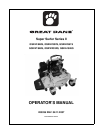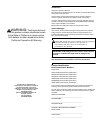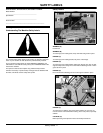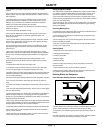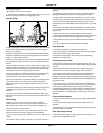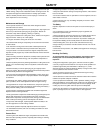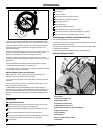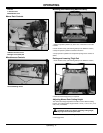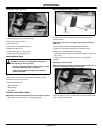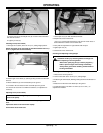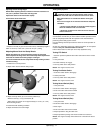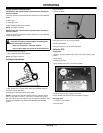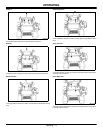
Safety - 6
SAFETY
• Wear close fitting clothing and safety equipment appropriate for the job.
• While mowing, always wear substantial footwear and long trousers. Do
not operate the equipment when barefoot or wearing open sandals.
• Wear a suitable protective device such as earplugs. Loud noise can
cause impairment or loss of hearing.
c
Maintenance and Storage
• Never operate machine in a closed area where dangerous carbon
monoxide fumes can collect.
• Disengage drives, lower implement, lock parking brake, stop engine and
remove key or disconnect spark plug (for gas engines). Wait for all
movement to stop before adjusting, cleaning or repairing.
• Clean grass and debris from cutting units, drives, mufflers, and engine to
help prevent fires. Clean up oil or fuel spillage.
• Let engine cool before storing and do not store near flame.
• Shut off fuel while storing or transporting. Do not store fuel near flames
or drain indoors.
• Park machine on level ground. Never allow untrained personnel to
service machine. Understand service procedure before doing work.
• Use jack stands or lock service latches to support components when
required. Securely support any machine elements that must be raised for
service work.
• Before servicing machine or attachment, carefully release pressure from
any components with stored energy, such as hydraulic components or
springs.
• Release hydraulic pressure by lowering attachment or cutting units to the
ground or to a mechanical stop and move hydraulic control levers back
and forth.
• Disconnect battery or remove spark plug (for gas engines) before
making any repairs. Disconnect the negative terminal first and the positive
last. Reconnect positive first and negative last.
• Use care when checking blades. Wrap the blades or wear gloves, and
use caution when servicing them. Only replace blades. Never straighten
or weld them.
• Keep hands, feet, clothing, jewelry and long hair away from moving
parts. If possible, do not make adjustments with the engine running.
• Charge batteries in an open well ventilated area, away from spark and
flames. Unplug charger before connecting or disconnecting from battery. •
Wear protective clothing and use insulated tools.
• Keep all parts in good working condition and all hardware tightened.
Replace all worn or damaged decals.
• Check grasscatcher components and the discharge guard frequently and
replace with manufacturer’s recommended parts, when necessary.
Grasscatcher components are subject to wear, damage, and deterioration
which could expose moving parts or allow objects to be thrown.
• Keep all nuts and bolts tight, especially blade attachment bolts, to be
sure the equipment is in safe working condition.
• Check brake operation frequently. Adjust and service as required.
• On multi-bladed machines, take care as rotating one blade can cause
other blades to rotate.
Prevent Fires
• Remove grass and debris from engine compartment and muffler area,
before and after operating machine, especially after mowing or mulching
in dry conditions.
• Empty the grasscatcher completely before storing.
• Always shut off fuel when storing or transporting machine, if the machine
has a fuel shutoff.
• Do not store machine near an open flame or source of ignition, such as a
water heater or furnace.
• Check fuel lines, tank, cap, and fittings frequently for cracks or leaks.
Replace if necessary.
Tire Safety
Explosive separation of a tire and rim parts can cause serious injury or
death:
• Do not attempt to mount a tire without the proper equipment and
experience to perform the job.
• Always maintain the correct tire pressure. Do not inflate the tires above
the recommended pressure. Never weld or heat a wheel and tire
assembly. The heat can cause an increase in air pressure resulting in a
tire explosion. Welding can structurally weaken or deform the wheel.
• When inflating tires, use a clip-on chuck and extension hose long
enough to allow you to stand to one side and NOT in front of or over the
tire assembly.
• Check tires for low pressure, cuts, bubbles, damaged rims or missing lug
bolts and nuts.
Handling Fuel Safely
To avoid personal injury or property damage, use extreme care in
handling fuel. Fuel is extremely flammable and fuel vapors are
explosive:
• Extinguish all cigarettes, cigars, pipes, and other sources of ignition.
• Use only an approved fuel container. Use only non-metal, portable fuel
containers approved by the Underwriter’s Laboratory (U.L.) or the
American Society for Testing & Materials (ASTM). If using a funnel, make
sure it is plastic and has no screen or filter.
• Never remove the fuel tank cap or add fuel with the engine running.
Allow engine to cool before refueling.
• Never add fuel to or drain fuel from the machine indoors. Move machine
outdoors and provide adequate ventilation.
• Clean up spilled fuel immediately. If fuel is spilled on clothing, change
clothing immediately. If fuel is spilled near machine, do not attempt to start
the engine but move the machine away from the area of spillage. Avoid
creating any source of ignition until fuel vapors have dissipated.
• Never store the machine or fuel container where there is an open flame,
spark, or pilot light such as on a water heater or other appliance.
c



